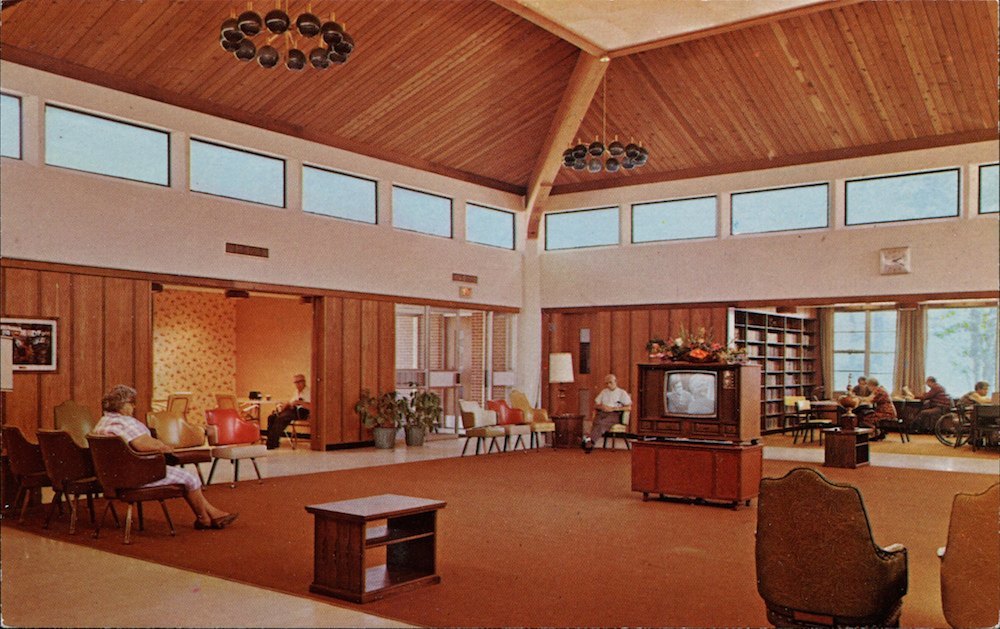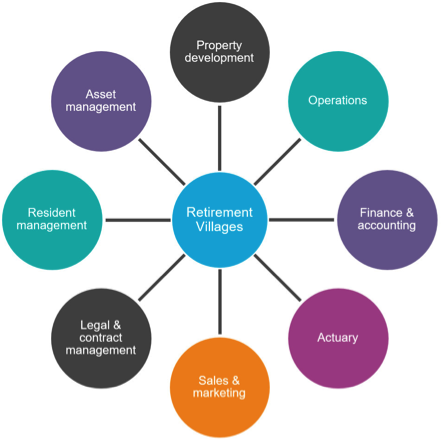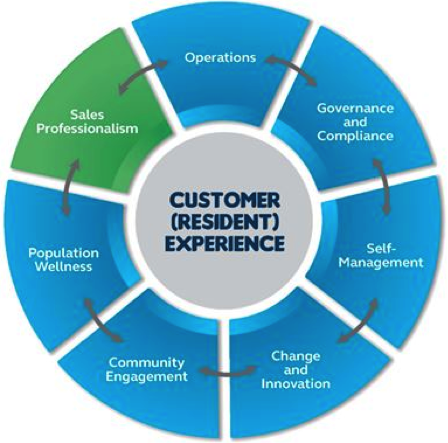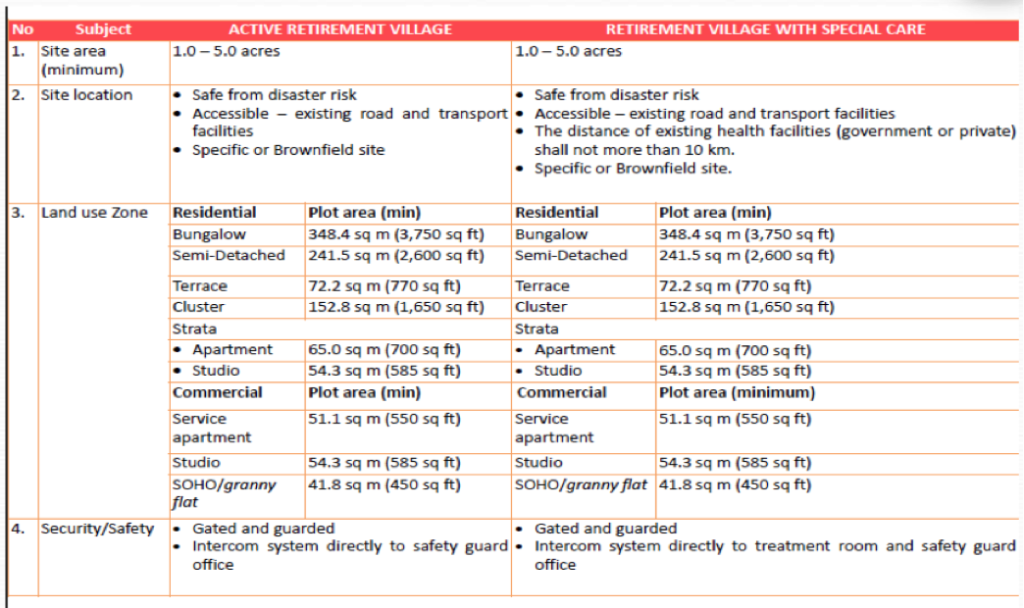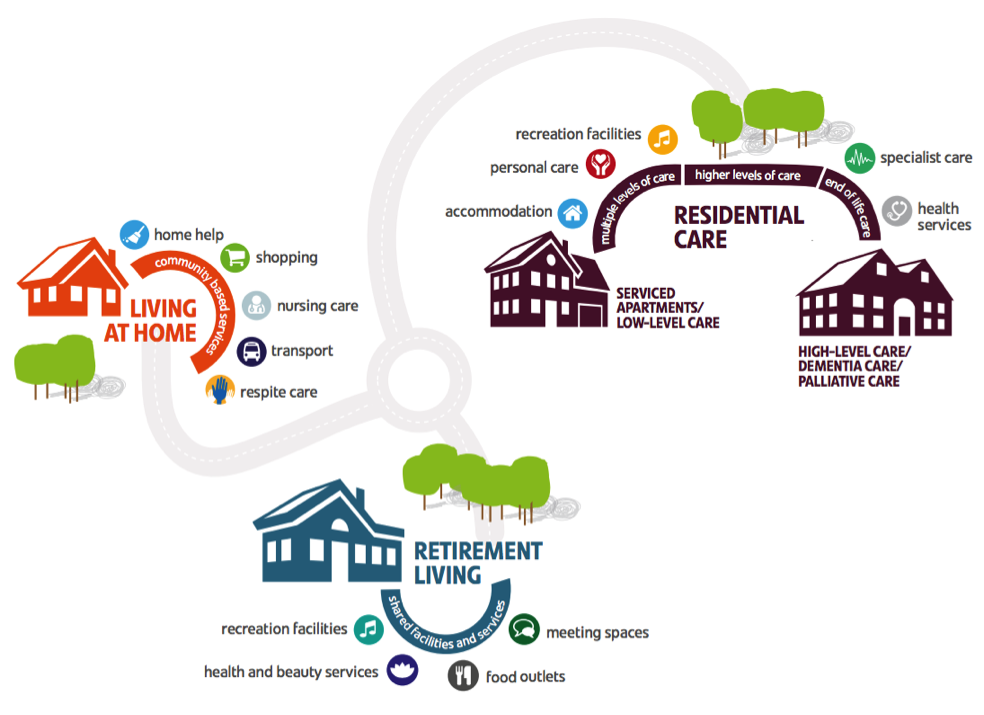“He makes me lie down in green pastures. He leads me beside still waters.”
Psalm 23:2 (ESV)
“The very first requirement in a hospital is that it should do the sick no harm.”
Florence Nightingale
Discover the purpose of your work and align it with your corporation’s mission.
What is your purpose in work?
• To bestow dignity and compassion upon the elderly during their journey through aging.
• To cultivate a secure and joyful residential environment for the senior demographic.
What drives your corporation’s core value?
• To transform Borneo into the premier destination for retirement living within the Asia Pacific region.
• To seize the prospect and serve the growing elderly population in Asia by delivering comprehensive and uninterrupted care for retirement communities.
Lutheran Hillside Village
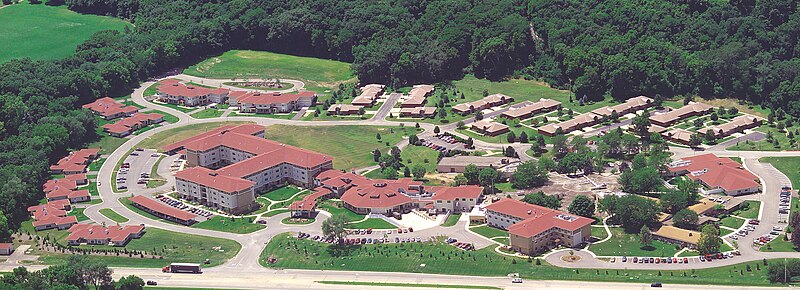
1.0 Executive Summary
Mission:
The mission is to establish ten new retirement community villages, comprising:
- 10,000 retirement homes
- 3,000 assisted living serviced apartments
- 1,000-bed nursing homes
- 1,000-bed dementia care nursing homes
Key Management Team:
- Mentors: Visionary pioneers and industry leaders with a vast global network, providing invaluable guidance and inspiration.
- Coaches: Mission-oriented industry experts offering practical solutions to challenges, ensuring a focused approach towards our objectives.
- Partners:
- International aged healthcare groups with a proven track record in planning, operation, financial, marketing, management, and cross-regional experience.
- Funding specialists with portfolios in retirement living and elderly care investments.
- Government agencies providing robust support for licenses, permits, and infrastructure.
- Local developers with access to land banks.
- Local community support groups catering to the holistic needs of retirees.
Product Benefits:
- Holistic: A comprehensive approach to the aging process.
- Stages: Continuous care within our retirement communities.
- Model: Adhering to high industry standards in Western nations for financial, operational, management, business model, and exit strategy.
- Team: Comprising top international management professionals with a history of success.
- Support: Strong governmental support backing our initiatives.
Target Market:
The target market includes Asian and foreign expatriates, professionals, affluent business managers, and employees of multinational corporations who are planning to retire in Asia.
Financial Projections:
- Property Investment: US$10.31 billion
- Property Revenue: US$12.90 billion
- Property Income: US$2.59 billion
- Care Service Cost: US$101.40 million/year
- Care Service Revenue: US$384.75 million/year
- Care Service Income: US$283.35 million/year
- Projected DMF Period: 10 years

Unique Business Model:
- Team: Comprising individuals with a successful track record in the international retirement village industry.
- Integration: Collaborating with top project leaders, international retirement village operators, securing solid funding, available land for development, and a robust strategy for our target market.
- Demand: Anticipating sustained high demand driven by the aging population in Asia.
2.0 Mission
2.1 Problem
- Aging: Asia’s rapidly aging population, expected to reach 1.3 billion by 2050, poses a significant challenge, especially in Japan, Korea, China, India, and Indonesia.
- Care: Quality retirement and aged care facilities are insufficient to meet the needs of retiring baby boomers.
- Limitation: Asian governments face immense pressure from state pension systems.
- Expertise: The region lacks sophisticated retirement infrastructure, financial planning, and facilities for middle-income and affluent baby boomers.
2.2 Solution
- Location: Borneo’s abundant land, skilled labour, cost-effectiveness, and natural beauty make it an ideal location.
- Timing: Now is the perfect time to invest in Borneo, building essential aged care infrastructure for retiring baby boomers.
2.3 Mission: Stage 1
- Goal: Establish Borneo as the premier Asia Pacific retirement destination.
- Entity: Partner with international developers, aged care operators, fund managers, investors, and target markets.
- Goals: Create ten retirement communities with:
- 10,000 retirement homes
- 3,000 assisted living apartments
- 1,000-bed nursing homes
- 1,000-bed dementia care units
Retirement village–types of homes and services
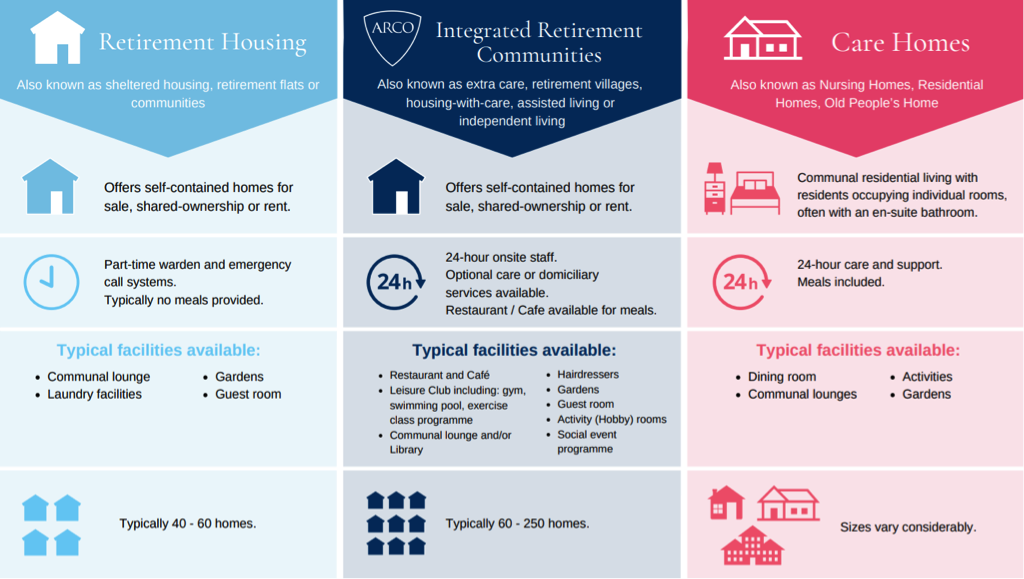
3.0 Product
3.1 Product Description
- Scope: The retirement village hub features independent homes, assisted living serviced apartments, and nursing homes with full-time care.
- Lifestyle: Catering to active baby boomers, the hub offers an alternative to traditional retirement living, promoting independence and an engaging lifestyle.
Retirement village community services
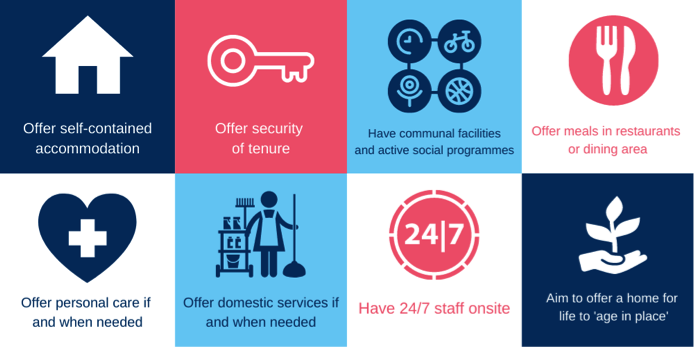
3.2 Product Attributes
- Needs: The retirement hub addresses physical, medical, social, psychological, financial, environmental, and spiritual needs of the elderly.
- Aging: Cater for various stages of aging:
- Retirement village: Active living (60-70 years)
- Service Apartment: Assisted living (70-80 years)
- Nursing Homes: Full-time professional care (80+ years)
- Special Homes: Dementia/Alzheimer’s care (80-90 years)
- Niche: Offer a range of deposit and service fees catering to both luxury and affordable markets.
- Support: Government policies, like Malaysia’s MM2H and Indonesia’s ITAS Lansia, support the retirement visa options.
- Length: Average stay durations in the USA:
- Independent living villa: 10-12 years
- Assisted living apartment: 1-2 years
- Nursing homes: 1-2 years
Holistic care for retire living
Length of stay in years – Australia
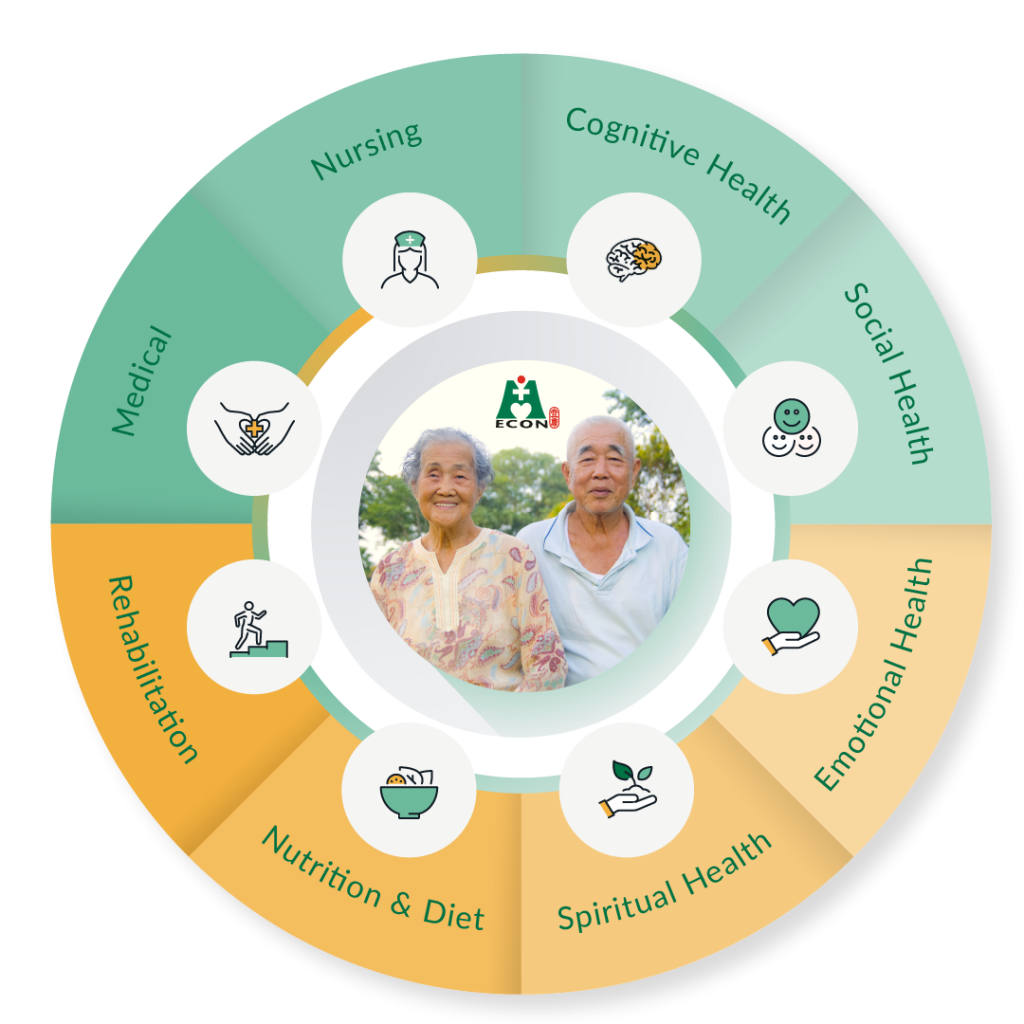
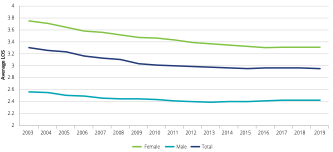
Source: Ecohealth 2021
Source: Aged Care Financing Authority Australian Gov. 2020
3.3 Product Benefits
Integrated retirement living provides:
- Holistic: A holistic approach to aging.
- Stages: Architecturally designed facilities meet current and future retiree needs.
- Model: High Western standards in finance, operations, management, and exit strategies.
- Team: An international management team ensures quality retirement living.
- Support: Asian governments back our hub, relieving their aged care burden as boomers transition away from traditional government care.
3.4 Product Competitive Advantages
- Specialist: Our unique collaboration of international and domestic specialists sets industry benchmarks and best practices.
- Stages: Holistic care covers the entire aging process.
- Market: Asian baby boomers, influenced by Western experiences, seek independent living.
- Location: Borneo’s natural beauty and strategic location appeal to upwardly mobile boomers looking for new experiences.
4.0 Market Segments
4.1 Market Segments
- Expat: Asian expatriate and diaspora retirees returning to Asia.
- APAC: Large corporation retirees, affluent and middle-income boomers nearing retirement.
- Niche: Professionals like doctors, lawyers, consultants, and financial planners seeking a like-minded retirement community.
4.2 Target Market Strategy
- North Asia: Japan, Korea, China – Focus on large conglomerates with loyal, lifelong employees for community-based retirement.
- Expat: Hong Kong, Singapore – Attract professionals, expatriates, and business managers planning Asian retirement.
- Colonial: United Kingdom, Netherlands – Appeal to former colonial nations seeking Borneo’s tropical environment and cost-effective living.
- Oceania: Australia, New Zealand – Leverage historical ties with Borneo.
- Local: Brunei, Indonesia, Malaysia – Offer an escape from crowded urban areas for local boomer retirees.
4.3 Market Needs
1. China:
- 2019: Over 50 million Overseas Chinese, including 9.3 million in Thailand, 7.67 million in Indonesia, and 6.84 million in Malaysia.
- 2017: Aged over 60 constituted 241 million people, or 17.3% of the population. The aged population is expected to reach 487 million, approximately 35% by 2050.
- 2018: 593,000 Chinese tourists visited Sabah.
2. Japan:
- 2017: Over 3.8 million Japanese diaspora, with significant populations in cities like Bangkok (52,000), Shanghai (43,000), Singapore (36,000), and Hong Kong (25,000).
- 2019: Aged over 65 accounted for 35.9 million people, roughly 28.4% of the population.
- LTCI: Japan’s Long Term Care Insurance (LTCI) is a key financial system for elderly care, highlighting a significant shortage of nursing homes, especially for dementia care.
3. Korea:
- 2018: 7.49 million South Korean nationals living overseas, with 337,000 South Korean visitors to Sabah in 2018.
- 2019: Aged over 65 amounted to 7.68 million people, about 14.9% of the nation’s population.
- LTCI: South Korea’s public Long Term Care Insurance (LTCI) covers nursing home services, addressing the need for elderly care.
Korea diaspora
Japan diaspora–2017
Overseas Chinese 2018

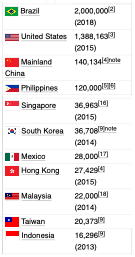
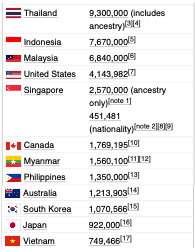
Source: The Korea Herald
Source: Wikipedia
Source: Wikipedia KD Nam 2019
4. Hong Kong
- 2019: Approximately 50,000 people emigrated during the last two quarters of 2019. In 2017, 6,500 individuals emigrated from Hong Kong. Figures for 2016 and 2015 were 7,600 and 7,000, respectively.
- 2019: The population aged over 65 was 1.3 million, accounting for 18% of the total population.
5. Indonesia
- 2019: The elderly population numbered 25.64 million, constituting 9.6% of the total population. Projections indicate that by 2035, the elderly population will rise to 40.95 million.
- Shortage: Indonesia faces a shortage of comprehensive elderly nursing care facilities.
6. Malaysia
- 2021: The population aged over 65 stands at 3.5 million, representing 7% of the total population. Projections show that by 2030, this figure will reach 15%, and by 2056, it will increase to 20%.
- MM2H: The Malaysia My Second Home Programme has attracted 42,000 foreigners.
- Immigrants: North Asia and Europe are the target markets for our retirement villages.
- Emigrants: We also consider the Malaysian diaspora of aging individuals who wish to return and retire in Malaysia.
7. Brunei
- 2020: The population aged over 60 was approximately 41,600 persons.
Hong Kong diaspora
Malaysia Immigrants
Malaysian diaspora
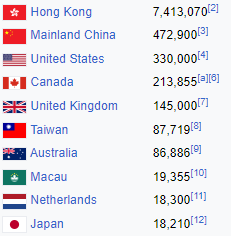
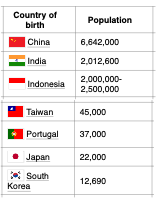

Source: Wikipedia
Source: Wikipedia
Source: Wikipedia
4.4 Growth Drivers
- Aged: The expanding elderly population in the Asia Pacific region is a significant growth driver.
- Freedom: With their children having moved out, retirees have newfound freedom to lead independent lives.
- Wealth: The increasing middle and affluent segments seek high-quality healthcare and improved retirement living.
- Lifestyle: A penchant for travel and appreciation of cultural diversity drive Asian boomers to seek safe retirement communities in different countries.
4.5 Key Customers
- China: Large conglomerates in energy, petroleum, financial institutions, telecommunications, mining, IT, digital trading, railway, ship, aerospace, and transportation equipment companies.
- Japan: Financial institutions, heavy industries, electronics, postal and communication, e-commerce.
- Korea: Electronics, financial groups, petrochemicals, telecommunications, and middle-class business entrepreneurs.
- Southeast Asia: Professionals, expatriates, middle-income groups, and business entrepreneurs.
China
Korea
Japan 2022
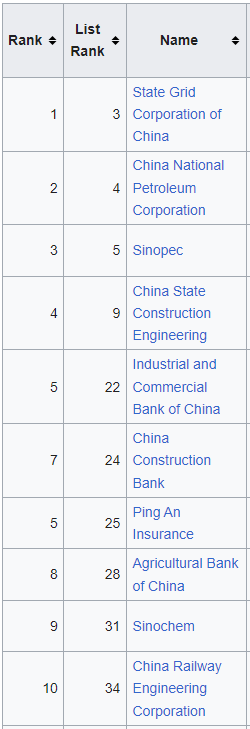
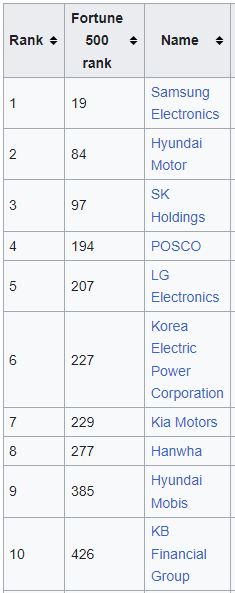
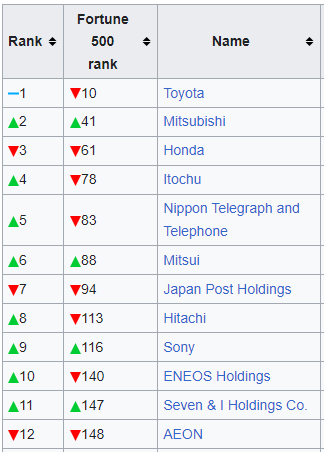
Source: Wikipedia 2020
4.6 Competition and Industry
1. International Key Players
France:
- Domitys
- Domus VI
- Korians
- Orpea Group
- Primonial REIM
Germany:
- Alloheim
- AWO
- Westf. Ev. Helmstiftung
- Azurit
- Die Johanniter
- Korian
- Kurasana
- Orpea
- Pro Seniore
- Vitana
Spain:
- Amavir
- Ballelsol
- Colisée
- Domus VI
- Korian Orpea
- Vitalia
- Sanitas
UK:
- Anchor Hanover
- Audley Villages
- Barchester Healthcare
- Beechcroft
- BUPA
- Care UK
- Four Seasons Health Care
- HC-One
- Inspired Villages
- McCarthy & Stone
- MHA (Methodist Homes for the Aged)
- Retirement Villages Group
- Richmond Villages
- Riverstone
USA:
- Atria Senior Living
- Brookdale Senior Living
- Capital Senior Living Corp
- Erickson Living
- Five Star Senior Living
- Holiday Retirement
- Life Care Centers of America
- Life Care Services
- Senior Lifestyle Corp
2. Asia Pacific Key Players
Australia:
- Allity Aged Care
- Arcare Aged Care
- Aveo Group (Brookfield)
- BlueCross
- Bupa
- Japara
- McKenzie Aged Care
- Opal
- Provectus Care
- Regis Healthcare
Brunei:
- Fera Health and Nursing Care
- Tamada Healthcare
China:
- Aixin Elder Care Group
- Baosteel Construction
- Cherish Yearn
- China Merchants Group
- China Senior Care
- Clifford Group
- Everbright Senior Healthcare
- Fantasia
- Fosun Group
- Golden Age Senior Care
- Greenland Group
- Hiking Group
- Huichen Elder Care
- Kaijian Huazhan Elder Care
- NCI
- Ping An Group
- Poly Real Estate
- Shanghai Industrial Investment
- Shangyou
- Sino-Ocean
- Starcastle Elderly Service
- Taikang Life
- Taiping Life
- Taiyangcheng
- Union Life
- Vanke Senior Housing
- Wuzhou Yada
- Yanda International
- Weisifuzhi Business Consulting
Indonesia:
- Jababeka Property and Long Life Holding (Japan) – Senior living in Cikarang.
- Ciputra Property and Living Well Senior Communities – Senior living projects in Jakarta.
- Sada Jiwa provides aged care residence in Bali.
Japan:
- Healthcare & Medical Investment (HCM)
- Kenedix Residential Next (KDR)
- Long Life Holding
- Medical Care Service
- Nichiigakkan
- Nippon Healthcare
- RIEI
- SPH
- Yushoukai Medical Corporation
Korea:
- Bayada Home Health Care
- Korean Home Health Care
Malaysia:
- Anglican Retirement Kampung
- Aragreens Residence
- Care Concierge
- ECON Healthcare Group
- Eden-on-the-Park
- Gracious Homes (Green Leaf)
- Greenacres
- Golden Heritage (Acacia Living Group)
- IHH Healthcare
- KPJ Healthcare
- LYC Healthcare
- Seavoy Nursing Homes
- Sri Seronok Retirement Village
- The Mansion Nursing Homes
5.0 Operation
6.0 Financial Implications
6.1 Investment Segment
Two segments:
- Property development investment
- Care service investment
Stage 1: Ten Continuing Care Retirement Community (CCRC)
- Retirement Village with community facilities:
- $100,000 X 10,000 Villas = $10.0 billion
- Assisted Living Apartment:
- $70,000 X 3,000 Units = $0.21 billion
- Nursing Home:
- $50,000/bed
- 1,000 beds X 50m2 X $1,000/m2 = $0.05 billion
- Dementia Nursing Home:
- $50,000/bed
- 1,000 beds X 50m2 X $1,000/m2 = $0.05 billion
Total = $10.31 billion
6.2 Production Cost
Care Service:
- Retirement Village with community facilities:
- $125/month X 10,000 Villas X 12 months = $15 million/year
- Assisted Living Apartment:
- $1,000/month X 3,000 Units X 12 months = $36 million/year
- Nursing Home:
- $1,800/month X 1,000 beds X 12 months = $21.6 million/year
- Nursing Care for Dementia:
- $2,400/month X 1,000 beds X 12 months = $28.8 million/year
Total = $101.4 million/year
6.3 Price and Revenue
- Property Development Revenue (25% Margin):
- Villa/Apartment: $10.31 billion X 1.25 = $12.9 billion
- (Repayment of the nursing homes will be based on a one-off deposit.)
- Refundable deposit: $50,000/bed
- Non-refundable building fund: 50K X 5% = $2,500/bed (20 years payback)
- Villa/Apartment: $10.31 billion X 1.25 = $12.9 billion
- Care Service Operation Revenue:
- Deferred Management Fee (Capped at 20% max.):
- $12.9 billion X 20% / 10 years = $258 million/year
- Operation Income (25% Margin):
- $101.4 million/year X 1.25 = $126.75 million/year
- Deferred Management Fee (Capped at 20% max.):
Total = $384.75 million/year
Case Studies
Case Study 1: Deferred Management Fee – Australia Retirement Village Example
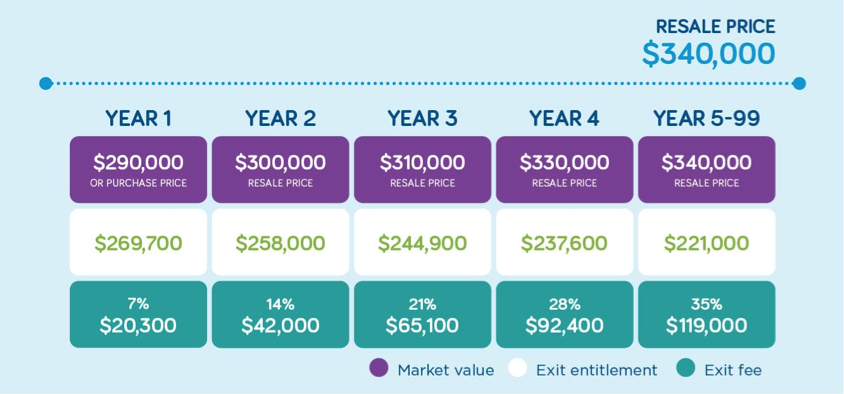
Case Study 2: Greenacres Malaysia
- Capacity: 170 units
- Lifelong lease: $71,000–$107,000/unit
- Recurring fee: Maintenance fee and sinking fund
Case Study 3: The Green Leaf Malaysia
- Capacity: 1,680 units
- Cost: $231,000–$632,000
Case Study 4: Aragreens Residence Malaysia
- Capacity: 700 units
- Cost: $283,000–$483,000/unit
Case Study 5: Eden-on-the-Park Malaysia
- Capacity: 104 units apartment, 14 Villas, and 71 aged care rooms.
- Cost: $189,000/unit
Case Study 6: The Mansion Nursing Homes/CARE Concierge Malaysia
- Capacity: 125 beds @ 3 nursing homes
- Cost: $900–$1,227/bed/month
Case Study 7: ECON Healthcare Group Singapore, Malaysia, and China
- Capacity: 1,400 beds @ 11 medicare and nursing homes.
- Earning/bed: $27,669,589/1,400 beds = $19,763/12 = $1,647/bed/month
Case Study 8: Seavoy Nursing Homes Malaysia
- Capacity: 2 nursing homes
- Cost: $472–$1,300/bed/month
Case Study 9: LYC Senior Living Malaysia
- Capacity: 10 nursing homes across five regions
- Cost: $307–$424/bed/week
Case Study 10: Senior Living D’Khayangan
- Capacity: 40 elderly phase 1
- Membership fee = $167,000/villa, $126,000/unit, plus health care fees.
Case Study 11: Sri Seronok Retirement Village Malaysia (NGO)
- Capacity: Over 30 units
- Rental: $248/month
6.4 Financial Returns

Case Study 1: Retirement Village Cost Australia 2018
- Entry price: $360,000
- Deferred management fee: 3% per year
- Capital gains: 50% of capital gains from the resale.
Case Study 2: Aged Care Feasibility Australia 2014
- Top EBITDA per bed: $15,250
- Average cost to build/bed: $175,000
- Average bond collected: $175,000
- Percentage of bed bonded: 40%
- Building Cost offset by bonds: $70,000
- Net investment: $105,000
- ROI: 14.5%
Case Study 3: Financial Returns of Aged Care Providers 2019 (Part)
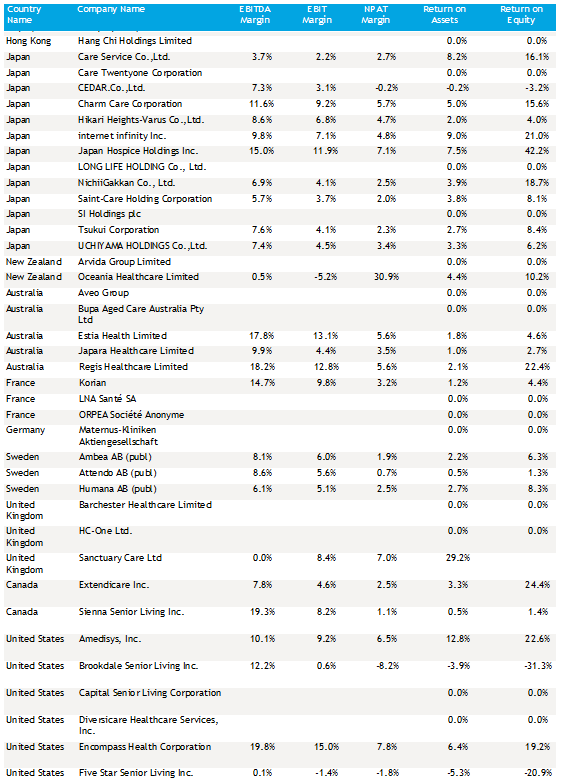
Case Study 4: International Comparisons of For-Profit Aged Care Margins and Returns 2018

Case Study 5: Financial Performances of Residential Care Providers, 2013 – 2019

2019 Financial Income of listed retirement living groups
International group
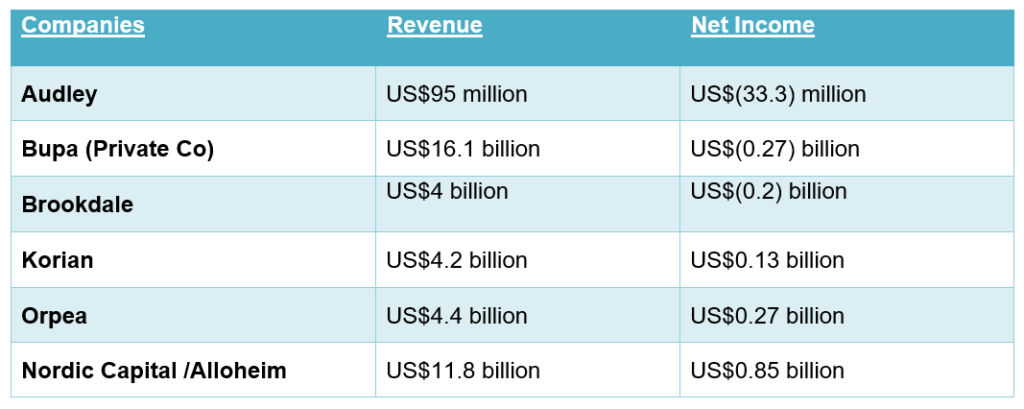
Asia Pacific group

6.5 Source of Funding
1. Strategic Investors:
- New investor: Project leadership team with a business and financial focus
- Financier: Retirement village private equity and investor groups
- Operator: Retirement village operator groups
- Developer: Retirement living project developers
- Target market: Asian MNCs with large employees
2. Private Equities and Investors
Fund investors:
- ActivumSG
- Aligned Equity Group
- AMP
- Anbang Insurance
- Apollo Global Management
- Auctus Capital Partners
- AXA
- Bain Capital
- Beijing Qing Geng Investment Management
- Berkadia
- BFT Investment Managers
- BlackRock
- Blackstone
- Bridgepoint Capital
- Brookfield
- Camber Capital Management
- Capital Funding Group
- Chicago Pacific Founders
- China Chengtong Asset Management
- China Everbright
- audleChina Railway Trust
- China Life
- Cindat Capital Management
- Columbia Pacific Management
- Comgest
- Corecam Capital Partners
- Craigs Investment Partners
- CVC Asia Pacific
- Denmark–China Elder Care Industry Investment Fund
- Dimensional Fund Advisors
- Eleva Capital
- Financière de l’Échiquier
- First REIT
- Formation Capital
- Fortress Investment Group
- Fosun International
- GIC
- Glenview Capital Management
- G. K. Goh Holdings
- Goldman Sachs
- GreenFort Capital
- Granite Growth Health Partners
- Hai Fan Elder Care Fund
- Harrison Street
- HCAP Partners
- Heitman Institutional Realty Advisors
- Helikon Investments
- IFM Investors
- JPMorgan Asset Management
- Kayne Anderson Capital Advisors
- KeyBank Real Estate Capital
- Khazanah Nasional Investment Company
- KKR
- Kong Capital
- Kuwait Investment Authority Investment Management
- Lone Star Funds
- Long Life Holding
- LongueVue Capital
- LTC Properties
- Lument
- Macquarie Capital
- Meridian Capital Group
- MidCap Financial Services
- Mirova SA
- Navigator Partners
- Nordic Capital
- Norges Bank Investment Management
- Octopus Real Estate
- Omega Healthcare Investors
- OMRAF
- Ostrum Asset Management
- ParkwayLife REIT
- Ping An Group
- Petra Capital Partners
- PGIM
- Quadrant
- Qualitas Group
- Renaissance Technologies
- Revelstoke Capital Partners
- Edmond de Rothschild Asset Management
- SC Capital Partners Group
- Schroder
- Senior Living Fund
- Stockland
- SV Health Investors
- Sycomore Asset Management
- Tasman Capital
- Tianjin Hongfu Equity Investment Fund Management
- Tigcorp
- TPG Capital
- ValStone Partners
- Vanguard Group
- Ventas
- VIUM Capital
- Vonovia
- Wells Fargo
- Yinhong (Tianjin) Equity Investment Fund
Investors – Operators:
- Almost Family
- Allity
- Ambea
- Amedisys
- Araco Ventures
- Arvida Group
- Attendo
- Australian Unity
- Audley Group
- Aura Holdings
- Aveo Group (Brookfield)
- Barchester Healthcare
- Bolton Clarke
- Brookdale Senior Living
- Bupa Aged Care Australia
- Capital Senior Living
- Care Service
- Carestone
- Care Twentyone
- Cedar
- Charm Care
- Colonial Oaks Senior Living
- Deutsche Wohnen
- Diversicare Healthcare Services
- Encompass Health
- Estia Health
- Extendicare
- Five Star Senior Living
- Genesis Healthcare Golden Heights
- Hang Chi Holdings
- HC-One
- HCR ManorCare
- Hikari Heights-Varus
- Humana
- Interim HealthCare
- Ingenia Communities
- Internet Infinity
- Japan Hospice Holdings
- Japara Healthcare
- Kindred Healthcare
- Korian
- Lend Lease
- LHC Group
- Lifestyle Communities
- LNA Santé
- Long Life Holding
- Longview Senior Housing
- Maternus-Kliniken Aktiengesellschaft
- MedCore Partners
- National HealthCare
- NichiiGakkan
- Oceania Healthcare
- Oncologix Tech
- Orpea Société Anonyme
- Platinum Senior Living Partners
- Provectus Care
- QSL Management
- Regis Healthcare
- Saint-Care Holding
- Sanctuary Care
- SI Holdings
- Sienna Senior Living
- SunLink Health Systems
- The Ensign Group
- Tsukui
- Uchiyama Holdings
- Vcanland
- Vitas Healthcare
- Watercrest
3. Consultants, developers and fund managers to the retiring living industries:
- Australian Aged Care Collaboration (AACC)
- ARCO UK
- Australian Retirement Village Residents Association (ARVRA)
- ASHA
- Blueprint
- CBRE
- Deloitte
- Greystone
- ImmoTISS Care
- International Council on Active Aging (ICAA)
- Indonesia Senior Living Association (ASLI)
- JLL Capital Markets
- Katharinenhof
- Knight Frank
- KPMG
- McKinsey
- National Investment Center for Seniors Housing & Care (NIC)
- Preqin
- PWC
- Retirement Village Association (RVA)
- Savills
- Senior Housing News
- Taikang Life
- Union Life
6.6 Value Enhancement Criteria:
- High Expectation Needs: Focus on luxury homes and resort-style amenities.
- Financial Affordability: Cater to million-dollar club members.
Demand Creation Methods:
- Exclusive: Target diverse nationalities, MNC managers, professional associations, affluent individuals, and culturally diverse backgrounds.
- Niche: Provide dedicated services similar to 5-star hotels, including massage, 24-hour concierge, gym, and more.
- Location: Offer options like beachfront villas, rainforest settings, golf courses, or tropical gardens.
- Capacity: Ensure demand consistently exceeds supply, maintaining over 100% occupancy rates.
- Medical: Collaborate with insurance companies, medical professionals, and healthcare providers, outsourcing specialized medical and healthcare components.
- Phasing: Implement a phased approach, with upgrades to 10% of the target market to increase revenue in Phase 2.
- Partnerships: Establish strategic partnerships with global luxury retirement communities for resident exchange visits via club memberships.
Additional Opportunities in the Retirement Living Industry in Asia:
- Training and Development: Offer programs for skilled caregivers.
- Education: Provide courses on business, operations, management, and hands-on skills related to retirement communities.
- Investment: Explore investment opportunities within the industry.
7.0 Management Team
7.1 Key Management Team
- Mentors: Visionary pioneers and industry leaders with a vast global network, providing invaluable guidance and inspiration.
- Coaches: Mission-oriented industry experts offering practical solutions to challenges, ensuring a focused approach towards our objectives.
- Partners:
- International aged healthcare groups with a proven track record in planning, operation, financial, marketing, management, and cross-regional experience.
- Funding specialists with portfolios in retirement living and elderly care investments.
- Government agencies providing robust support for licenses, permits, and infrastructure.
- Local developers with access to land banks.
- Local community support groups catering to the holistic needs of retirees.
In the aged care industry, several global leaders have made significant contributions, shaping its growth and success. Here is a list of some of these remarkable individuals, honoured for their vision and dedication:
These are just a few of the outstanding professionals and captains of the industry. The readers are encouraged to explore further and conduct their research to learn more about the management teams in this dynamic field.
7.2 Key Management Team Model

8.0 Unique Business Model
8.1 Successful Track Record:
- A management team with a proven track record in retirement living and elderly care.
- Financial specialists with solid funding and a focus on financial goals.
- Early adoption of advanced healthcare technology, modern equipment, new management systems, and operational excellence benchmarks.
- Australia’s Industry Strength: Drawing inspiration from Australia’s successful model.
8.2 Entry Model:
- Joint Venture (JV): Collaboration among stakeholders with financial, operational, and management expertise.
- Project Leader: Appointing a project leader to lead the international retirement living team.
- Operator Involvement: International retirement village operators contribute their brand, intellectual property, operations, and management expertise for a franchise fee, management agreement, or partnership with financial rewards.
- Financial Backing: Private equity funds and private investors provide financial support.
- Developer Participation: Local property developers supply the land, leveraging the prestigious brand of the international retirement village team to increase property project value.
Unique Business Model Features:
- Integration: Collaboration of top specialist teams in the retirement village industry.
- Market Segmentation: Precisely defined target market segments and their needs.
- Reputable Branding: Trusted reputation of international operators.
- Financial Stability: A reliable source of funding.
9.0 Key Success Factors & Risk Mitigation
9.1 Key Success Factors:
- Land: Secure competitive land leases through local developers.
- Customers: Attract commitments from target customers, especially MNCs, pre-construction.
- Team: Partner with experienced international retirement and elderly care operators.
- Growth: Capitalize on rising demand from baby boomers.
9.2 Risks:
- Political: Concerns over government changes impacting bankability.
- Economic: Vulnerability to global and regional economic downturns.
- Legal: Risks related to legal and ownership structures.
- Environmental: Exposure to natural disasters, pandemics, and health concerns.
- Business: Risks associated with achieving financial and operational goals.
9.3 Risk Mitigation:
- Policy: Establish supportive government policies.
- Revenue: Target boomers with savings and superannuation funds.
- Contracts: Use successful industry models for legal and contractual structures.
- Insurance: Mitigate risks with defined insurance parameters.
- Audit: Regular audits enhance business performance and reduce risk.
10.0 Exit Strategy
10.1 Forms of Exit:
The exit strategy can take various forms, including IPO, buy-out, M&A, and transfer.
10.2 Key Attractions for New Investors:
- Portfolio: Retirement projects offer stable returns for asset investments.
- Unique: Unique business features provide a competitive edge.
- Barrier: High barriers to entry due to the high cost and complexity of the investment.
- Price: Consistent price increases in line with inflation.
- Growth: Opportunity to capture strong demand in Asia’s ageing population.


